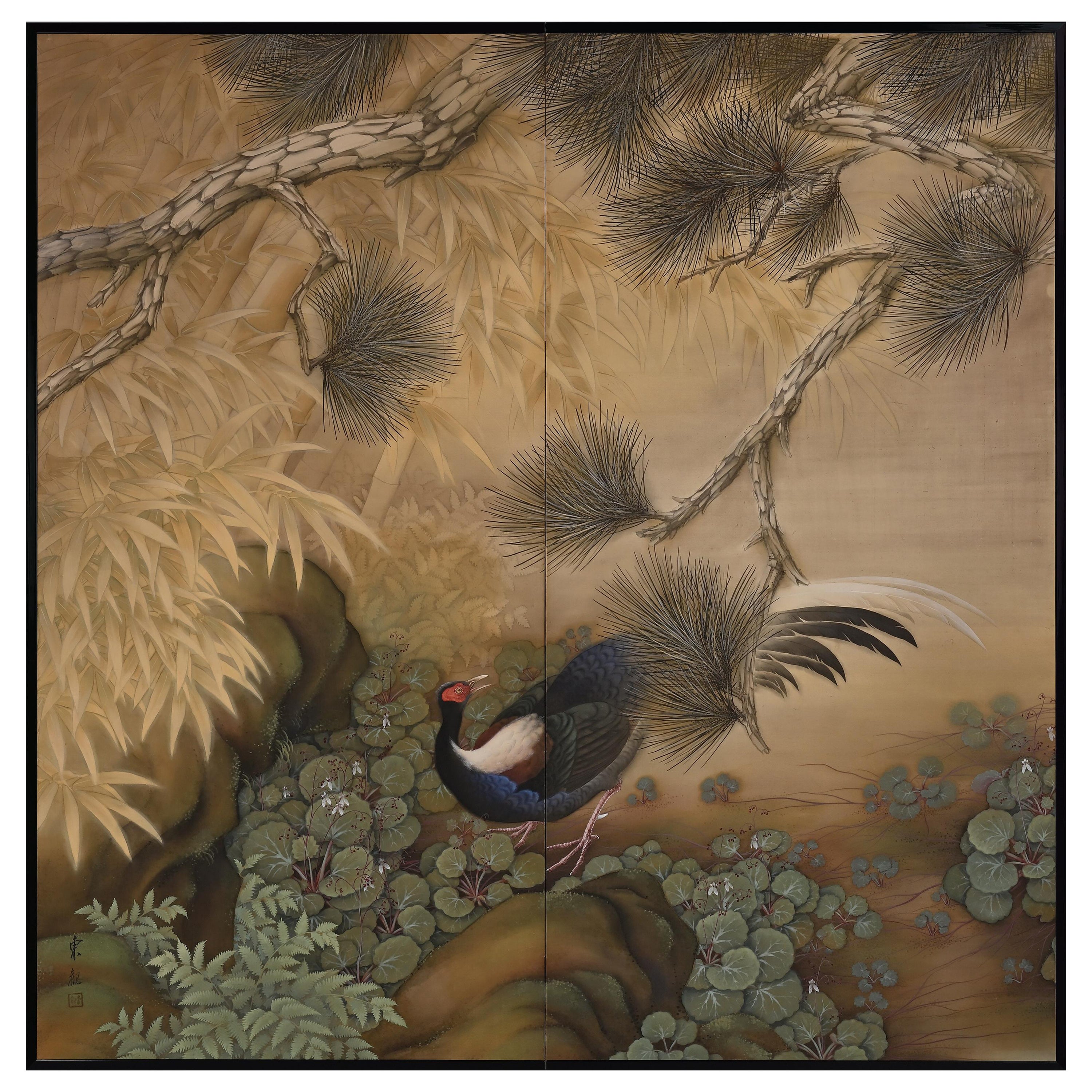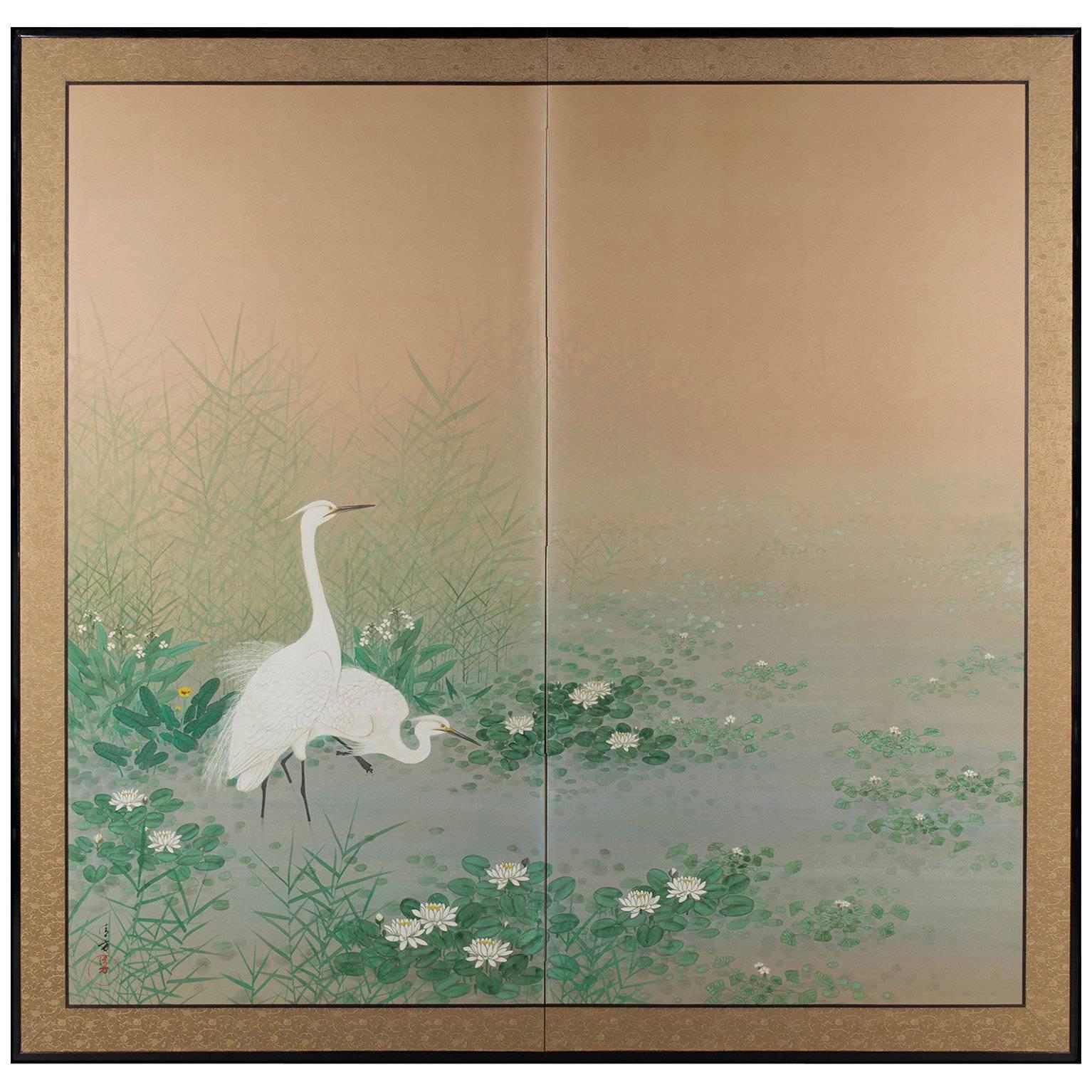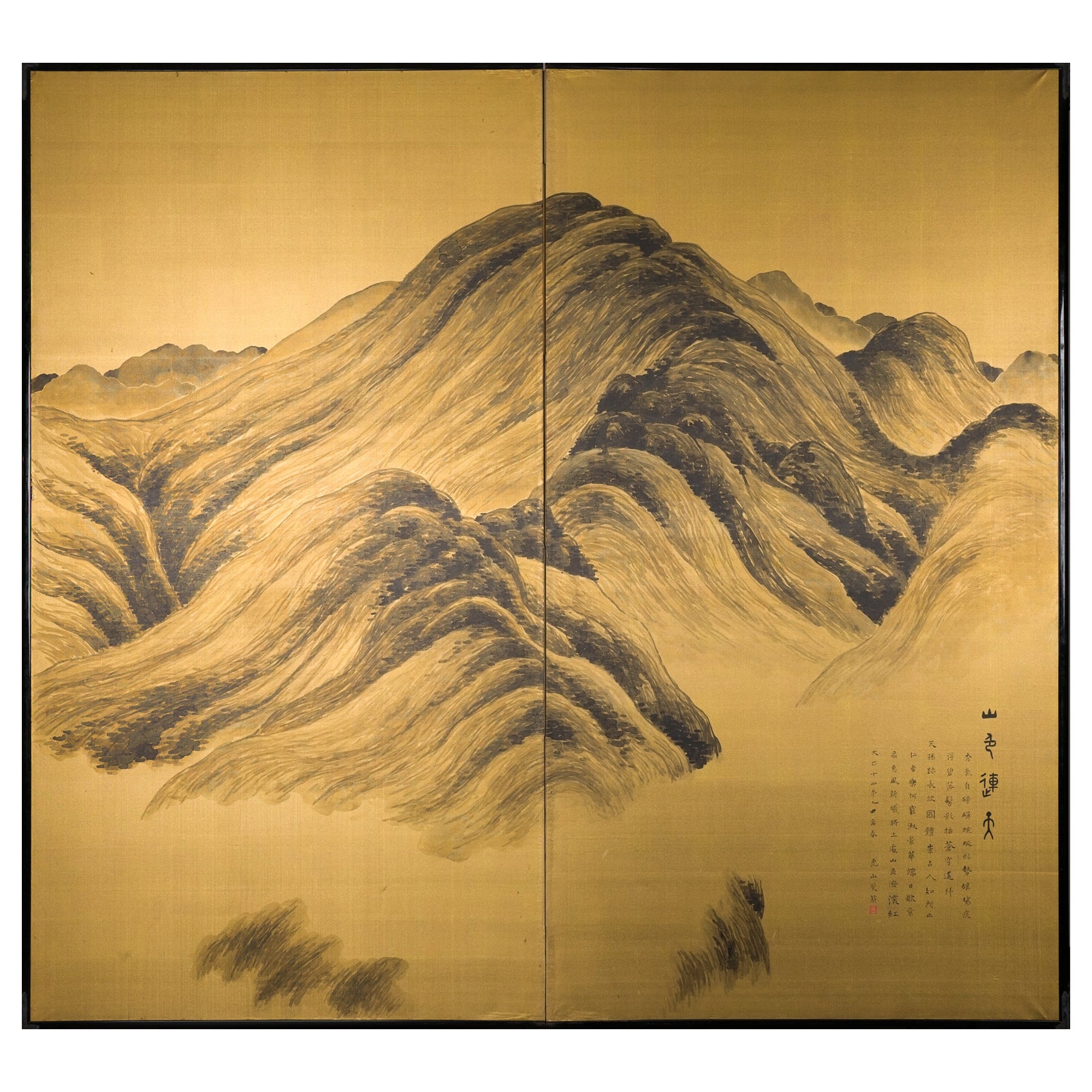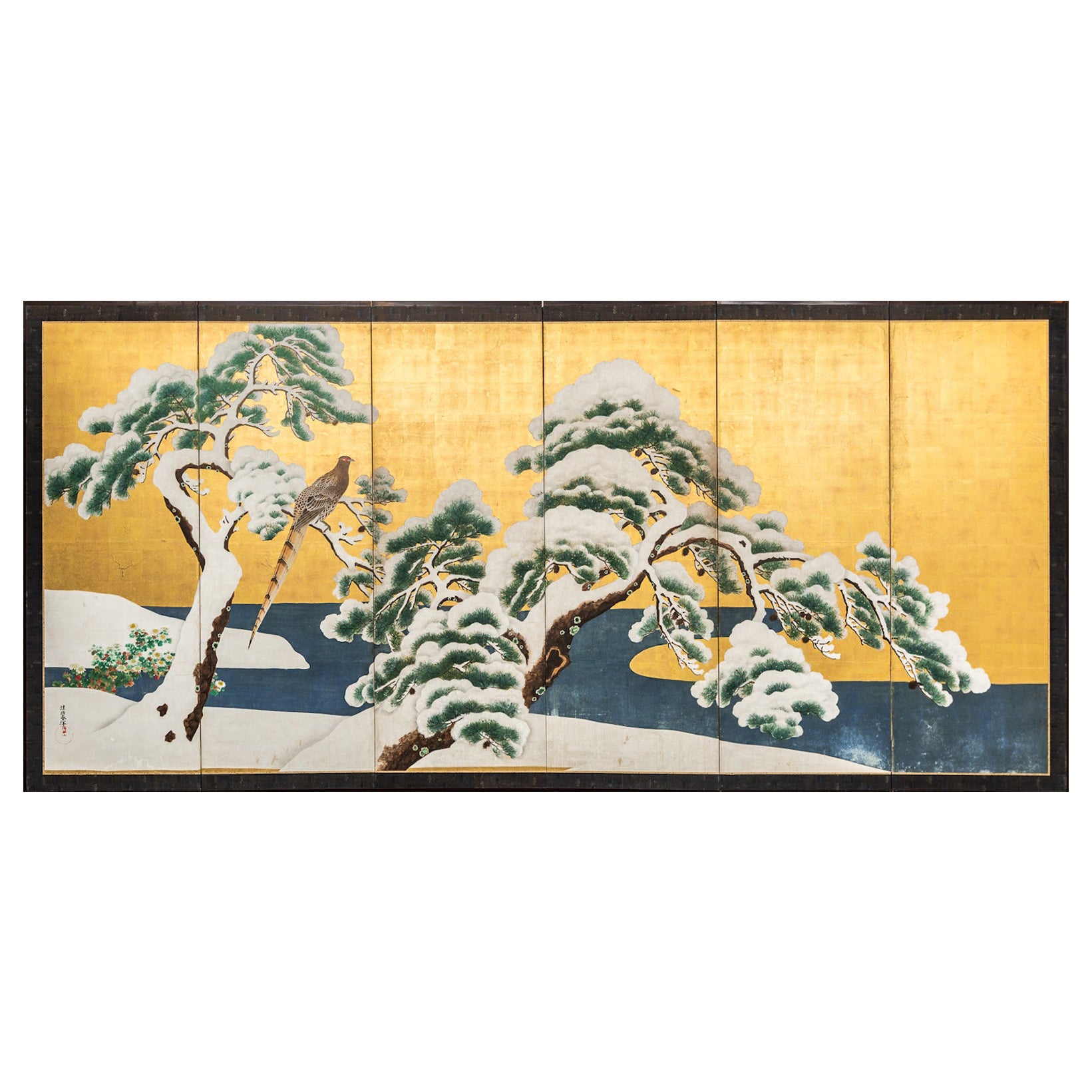Items Similar to Circa 1920 Japanese Screen. Cat & Mouse Harvest Scene on Gold Silk.
Want more images or videos?
Request additional images or videos from the seller
1 of 9
Circa 1920 Japanese Screen. Cat & Mouse Harvest Scene on Gold Silk.
About the Item
The narrative playfulness of the scene depicted on this Japanese screen sets alight what is at its core a celebration of a bountiful harvest. The screen offers a visual representation of the abundance of nature and the wish for ongoing prosperity. It is closely tied to the seasons and in this case spring, summer, autumn and winter are all represented. The plethora of freshly harvested vegetables includes new season ginger, Chinese wax gourd, butterbur, welsh onion, Japanese radish, sweet potato, lotus root, soy beans and aubergine. The artist has employed meticulous attention to detail in the depiction of the vegetables as well as the use of vibrant colors and an intricate composition to bring the scene to life, but ultimately the cat and mouse steal the show. It is a stunning example of capturing the lifelike qualities of a cat, portrayed with an intense focus on its movement and expression. Hidden amongst the aubergines is the protagonist of the scene; a small grey mouse. In pursuit, the cat has upended the basket of vegetables. We can still sense the aubergines rolling. The mouse’s body shape and tail mimic the aubergines and the cat has caught the wrong tail.
Otaki Uzan (1871-1939) studied painting with Entan Ichihara and Haizan Ishikawa. He later moved to Tokyo and studied under Amaya Kawamura. and was predominantly known for his landscape paintings. He was a decorated artist and served as a member of the Japan Art Association and as a councllior of the Japan Nanshu (Southern school of Chinese painting) Association. He was a regular national exhibitor and awarded artist. He exhibited at the Japan Painting Association in 1909, 1910, 1912 (honorable mention), 1913,1914 (commendation), 1915 (3rd prize and silver medal), 1916 (bronze medal), 1917 (bronze medal), 1918 (bronze medal), 1919 (bronze medal), 1923, 1924, 1926, 1928 and 1933. He was also selected to exhibit with the Bunten in 1915 and 1916.
- Dimensions:Height: 54 in (137.16 cm)Width: 107.5 in (273.05 cm)Depth: 0.75 in (1.91 cm)
- Style:Taisho (Of the Period)
- Materials and Techniques:
- Place of Origin:
- Period:
- Date of Manufacture:Circa 1920
- Condition:Refinished. Wear consistent with age and use. The screen has recently been completely remounted utilizing traditional craftsmen and techniques.
- Seller Location:Kyoto, JP
- Reference Number:1stDibs: LU2472336431902
About the Seller
5.0
Recognized Seller
These prestigious sellers are industry leaders and represent the highest echelon for item quality and design.
Gold Seller
These expertly vetted sellers are highly rated and consistently exceed customer expectations.
Established in 2001
1stDibs seller since 2016
60 sales on 1stDibs
Typical response time: 6 hours
- ShippingRetrieving quote...Ships From: Kyoto, Japan
- Return PolicyA return for this item may be initiated within 10 days of delivery.
More From This SellerView All
- Japanese Screen. Taisho era Circa 1920. Pheasant in Deep Forest. Color on Silk.Located in Kyoto, JPOsawa Tokan (b. 1899) In the Forest Two-panel Japanese screen. Ink, color and gofun on silk. A major work of oversized proportions combining an intimate, naturalistic depiction of...Category
Early 20th Century Japanese Taisho Paintings and Screens
MaterialsSilk
- Japanese Framed Silk Painting, Turtledoves and Peaches, Taisho Era, circa 1920Located in Kyoto, JPNakamura Daizaburo Turtledoves in a Peach Tree Taisho period, circa 1920 Framed painting. Mineral pigments, ink and gofun on silk Signed: Daizaburo Dimensions (framed)...Category
Vintage 1910s Japanese Taisho Paintings and Screens
MaterialsWood, Silk
- Japanese Painting, Hanging Scroll, 'Playful Cat' by Hirose Toho, 1920s TaishoBy Hirose TohoLocated in Kyoto, JPPlayful Cat Hirose Toho (1875-1930) Hanging scroll, ink, mineral pigments and gofun on silk. Painting inscription: Toho Sha Painting seals: Upper - Hirose Hitoshi Lo...Category
Vintage 1920s Japanese Taisho Paintings and Screens
MaterialsSilk
- Japanese Painting, Framed Panel, Dahlias and Roosters, circa 1920Located in Kyoto, JPTanaka Tessen (b.1890) Dahlias and Roosters Taisho period, circa 1920 Framed painting. Mineral pigments and ink on silk. Dimensions (framed): H. 159 cm x W. 97 cm x D. 2.5 cm (62.5” x 38” x 1”) An ornate and complex composition in which the artist explores almost the entire painting surface. The coloration is bold and evocative and the tinted silk ground recreates the warm golden glow of sunset. Soft, luminous brushwork details the black feathers of the roosters, which seem to cloud and blur in counterpoint to the sharper points of the eyes and beaks. Their brilliant red combs balance the composition, echoing the rich burgundy hues of the dahlias; the flowers exquisite and lifelike. Dahlias were an exotic subject favored by painters of the Taisho era. The painting belongs to the school of Kyoto Nihonga, exemplifying the principles of decorative elegance and consumate brush technique with which it was intimately associated. Painters of the time relied on the Shijo school method, basing the forms of the composition from life sketches. Sometimes they were then integrated with elements derived from Chinese bird and flower...Category
Vintage 1920s Japanese Taisho Paintings and Screens
MaterialsSilk, Wood
- Japanese Screen Painting, Cat & Pumpkin Patch. Showa Era, 1940sLocated in Kyoto, JPChuichi Konno (1915-2006) Cat and Pumpkin Patch Showa period, 1940s. Folding screen in two-panels. Painted on paper with mineral pigments and gofun. Sign: Chuichi Sea...Category
Vintage 1940s Japanese Showa Paintings and Screens
MaterialsPaper, Wood
- Early 20th Century Japanese Framed Painting, White Peacocks on Silk and GoldLocated in Kyoto, JPKasahara Seiken White peacocks, circa 1916 Framed painting. Ink, color and gofun on silk. A Taisho period Japanese nihonga painting depicting a pair of white peacocks re...Category
Early 20th Century Japanese Taisho Paintings and Screens
MaterialsGold Leaf
You May Also Like
- Japanese Four Panel Taisho Period Screen Bamboo & Blossom, circa 1920Located in London, GBJapanese four panel Taisho Period (1912-1926) screen. Depicting bamboo, blossom and birds in flight. Signed. Mineral pigment on mulberry paper with silk brocade border, within a lac...Category
Vintage 1920s Japanese Taisho Paintings and Screens
MaterialsSilk, Paper
- Japanese Screen of Spring on Gold LeafLocated in Brescia, ITIt is a two-panel screen from the Taisho period, around 1920, beautifully painted in excellent detail. The best of Rinpa's school painting: large empty space that highlights a pair of mandarin ducks in the middle of the pond. On the right, flying birds give the painting a great lightness, under many multicolored flowers they celebrate spring. All very proportionate and pleasant, the dimension really interesting. Mineral pigments on gold leaf. It turns out Anonymous. Lucio Morini.Category
Early 20th Century Japanese Taisho Paintings and Screens
MaterialsGold Leaf
- "Egrets Amongst Lotuses" Japanese Paper Byobu Screen, c. 1920Located in Chicago, ILEverything about "Egrets Amongst Lotuses" is timeless and delicate, particularly the fine paper, soft colors, and detailed brushstrokes. The painting is signed Kyokata and dates to t...Category
Early 20th Century Japanese Taisho Paintings and Screens
MaterialsSilk, Wood, Paper
- Japanese Two Panel Screen Mountain Landscape on Gold SilkLocated in Hudson, NYNanga School; by female artist Kia Kozan. Showa Period (1926-1989) Translation: Kai Kozan 1867-1961, from Bungo area in Kyushu. Graduated from Bunchu-en Girls School. Signature and s...Category
Mid-20th Century Japanese Paintings and Screens
MaterialsPaper
- Japanese Six Panel Screen: Snow SceneLocated in Hudson, NYKano school painting of a pheasant in a snowy pine. Artist signature reads: Hokkyo Shunyo. Mineral pigments on gold leaf with silk brocade border.Category
Antique Early 19th Century Japanese Paintings and Screens
MaterialsGold Leaf
- Set of Four Japanese Silk Hanging Scrolls Screens C.1920Located in London, GBA stunning set of four Japanese silk mounted vertical hanging scrolls. Dating from C.1920 Taisho Period. The watercolour and ink on silk depicts a larg...Category
Vintage 1920s Japanese Japonisme Paintings and Screens
MaterialsSilk
Recently Viewed
View AllMore Ways To Browse
Japanese Root Basket
Mouse Japanese Bronze
Japanese Antique Screen
Japanese Silk Landscape
Taisho Screen
Taisho Screens
Japanese Screen Four Seasons
Art Silk
Soapstone Pagoda
Japanese Art Brocade Panels Frame
Mineral Pigment
Brocade Japanese Art
12 Panel Coromandel
Chinese Japanese Art On Wood Panels
Qing Dynasty Room Divider
Wood Coromandel 6 Fold
Asian Six Panel Floor Screens
Buddhist Tibetan Scroll Painting





